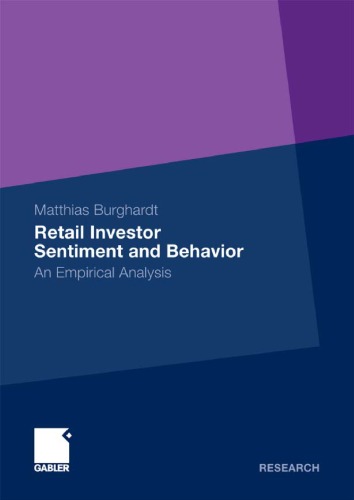

Most ebook files are in PDF format, so you can easily read them using various software such as Foxit Reader or directly on the Google Chrome browser.
Some ebook files are released by publishers in other formats such as .awz, .mobi, .epub, .fb2, etc. You may need to install specific software to read these formats on mobile/PC, such as Calibre.
Please read the tutorial at this link: https://ebookbell.com/faq
We offer FREE conversion to the popular formats you request; however, this may take some time. Therefore, right after payment, please email us, and we will try to provide the service as quickly as possible.
For some exceptional file formats or broken links (if any), please refrain from opening any disputes. Instead, email us first, and we will try to assist within a maximum of 6 hours.
EbookBell Team

4.4
42 reviews
ISBN 13: 9783834927132
Author: Matthias Burghardt
Using a unique data set consisting of more than 36.5 million submitted retail investor orders over the course of five years, Matthias Burghardt constructs an innovative retail investor sentiment index. He shows that retail investors’ trading decisions are correlated, that retail investors are contrarians, and that a profitable trading strategy can be based on these aggregated sentiment measures.
1 Introduction
1.1. Motivation
1.2. Research Outline
1.3. Overview and Structure
1.4. Related Publications
2 Related Theoretical and Empirical Work
2.1. Introduction to Behavioral Finance
2.1.1. Are Financial Markets Efficient?
2.1.2. Challenges to Efficient Markets
2.1.3. Emergence of Behavioral Finance
2.2. Theoretical Work
2.3. Empirical Work
2.3.1. Noise Traders
2.3.2. Investor Sentiment
2.3.3. Individual Investors
2.3.4. Correlated Trading
2.4. Discussion
2.4.1. Behavioral Finance
2.4.2. Correlated Trading
2.4.3. Return Correlation
2.4.4. Market Efficiency
2.5. Conclusion
3 Investor Sentiment Construction
3.1. Classification of Sentiment Measures
3.1.1. Related Work
3.1.2. Advantages and Disadvantages
3.2. Sentiment Measures in Research
3.2.1. The Closed-End Funds Discount
3.2.2. Meta-Measures
3.3. Sentiment Measures in Practice
3.3.1. Survey-Based Measures
3.3.2. Market-Data-Based Measures
3.3.3. Meta-Measures
3.3.4. Summary Statistics
3.4. Evaluation of Sentiment Measures
3.4.1. Direct Sentiment Measures
3.4.2. Indirect Sentiment Measures
3.4.3. Direct vs. Indirect Sentiment Measures
3.4.4. Sentiment Measures vs. Market Returns
3.4.5. Review of Results
3.5. Conclusion
4 Construction of the Euwax Sentiment Index
4.1. Introduction
4.1.1. Securitized Derivatives
4.1.2. European Warrant Exchange
4.1.3. Key Facts
4.2. Data Set
4.3. Basic Index Calculation
4.4. Sentiment Analysis
4.4.1. Numbervs. Volume-Based Measures
4.4.2. Product Types
4.4.3. Order Types
4.4.4. Order Volume Groups
4.4.5. Submitted Orders
4.4.6. Leverage
4.5. Comparison with Other Sentiment Measures
4.5.1. Indirect Sentiment Measures
4.5.2. Direct Sentiment Measures
4.5.3. Review of Results
4.6. Conclusion
5 Retail Investor Herding
5.1. Introduction
5.2. Related Work
5.2.1. Definitions of Herding
5.2.2. Empirical Findings
5.2.3. Discussion
5.3. Evidence of Market-Wide Herding
5.3.1. Data
5.3.2. Herding Measure Construction
5.3.3. Results
5.3.4. Review of Results
5.4. Market-Wide Herding on a Broker Level
5.4.1. Data
5.4.2. Results
5.4.3. Review of Results
5.5. Stock-Level Herding
5.5.1. Data
5.5.2. Herding Measure
5.5.3. Results
5.5.4. Review of Results
5.6. Conclusion
6 The Predictive Power of Retail Investor Sentiment
6.1. Related Work
6.2. Data and Methodology
6.2.1. Data Set
6.2.2. Methodology
6.3. Results
6.3.1. Preand Post-Portfolio-Formation Returns
6.3.2. Control Variables
6.3.3. Portfolio Holding Returns
6.4. Robustness Checks
6.5. Conclusion
7 Conclusion and Future Work
7.1. Conclusion
7.2. Summary of Contributions
7.3. Future Work
retail investor sentiment and behavior
retail investor sentiment indicator
retail investor sentiment
retail investor activity
retail investor relations
retail investor index
Tags: Matthias Burghardt, Retail, Investor